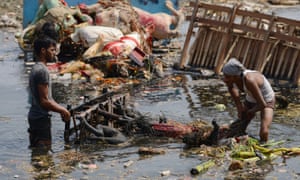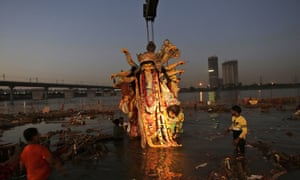
Sections of a major river in Delhi are choking with plastic, flowers and debris after an annual Hindu festival in which hundreds of idols were immersed in Indian waterways.
The 10-day Durga Puja, which celebrates the victory of the goddess Durga over the buffalo demon Mahishasura, concluded over the weekend with mass immersion ceremonies across the Indian subcontinent.
Enormous and elaborate likenesses of Durga – usually depicted with 10 arms and riding a lion – were paraded through cities and villages by devotees on Saturday and then cast into water, symbolising the goddess’ return to her mythological home on Mount Kailash.
But in the days after the festival, waterways dense with debris, rubbish and flowers have become a regular sight, particularly in large population centres such as Delhi, whose main river, the Yamuna, is already one of the most polluted in India.
Indian courts have tried to mitigate the environmental damage by banning the immersion of idols made from non-biodegradable materials such as gypsum plaster.

In many cities, including Delhi, the immersions are permitted only in select areas of the river that are fenced off to prevent pollution flowing into the stream.
But Sanjay Upadhyay, an environmental lawyer who has fought for regulation of the ceremony, said there was little enforcement of the court orders in the Indian capital.
“There is no check on whether a particular idol is biodegradable, or whether the non-biodegradable material has been removed before the idol is immersed,” he said.
Nor was there a coordinated effort to manage the use or clean-up of the Yamuna after the festival, he added.
The immersions have taken place in some form since at least the 14th century, but Upadhyay said the sheer scale of modern ceremonies was overwhelming the Yamuna.
Idols were also immersed in the Yamuna last month for Ganesha Chaturthi, a 10-day festival in honour of the Hindu god Ganesh.“It’s about numbers,” he said. “We are a huge country and a huge place in Delhi. It’s the magnitude, and what little happens to mitigate that.”
The environmental toll of large religious festivals is becoming increasingly evident across South Asia.
Air pollution after Diwali – in which thousands of fireworks are set off across the subcontinent – led to schools and construction sites being shut down in Delhi last November.
In Dhaka, the Bangladesh capital, last year heavy rains and poor drainage led to torrents of blood in the streets when thousands of animals were sacrificed for the annual Islamic festival Eid al-Adha.

No comments:
Post a Comment